West End Workbench
Moderators: 52D, Tom F, Rlangham, Atlantic 3279, Blink Bonny, Saint Johnstoun, richard
- Atlantic 3279
- LNER A4 4-6-2 'Streak'
- Posts: 6660
- Joined: Fri Jun 26, 2009 9:51 am
- Location: 2850, 245
Re: West End Workbench
While you were typing that I was typing this.
Yes, from reasonable viewing range the DJH loco convinces me at any rate. As has been alluded to previously in specific connection with the tender, there is significant distortion of dimensions below the running plate, possibly for the sake of wheel clearances (and we all want the locos to run properly rather than just look nice), possibly also in line with (or for compatibility with) the prevailing RTR tendency of former years for having running plates and buffers too high. I reckon my loco and tender sit about 1.5 mm too high at running plate level. Before we whine too much about that, I think we ought to take a seriously hard look at Hornby's current "marvellous" LNER Pacifics which I'm sure are STILL slightly too tall if we're getting pedantic. Also, DJH have extended the front of the Atlantic running plate by something like an extra 2mm ahead of the smokebox front, but at least that gives the bogie wheels somewhere to go when running around model railway curves.
Below are other figures, listed as: my built-up DJH model, then scale, then % enlargement:
Coupled wheelbase: 28.5 / 27.3 / 4.4%
Total loco WB : 109 / 105.4 / 3.4%
Running plate length 138 / 133 / 3.8%
Cab height 32 / 31.5 / 1.5%
Smk box front to cab 109.5/ 108 / 1.4%
Clad boiler diam. 23.2 / 23.2 / spot-on!
Smk box diam. 25 / 24 / 4% (pity about that, I should have had my big file out....)
It doesn't appear to me that there is any "consistent" increased scale to which the model was designed, and certainly not one of as much as 4.25mm:1 foot which would be 6.25% too large. Although the height to running plate is around 8.5% too much, the total height is less than 4% too great. Although DJH deserve no credit for their suggested arrangement for the rear carrying axle's suspension, I think they made a pretty fair job of designing a loco that could be built, would still look convincing and would actually work with the wheels on offer to most at the time.
Yes, from reasonable viewing range the DJH loco convinces me at any rate. As has been alluded to previously in specific connection with the tender, there is significant distortion of dimensions below the running plate, possibly for the sake of wheel clearances (and we all want the locos to run properly rather than just look nice), possibly also in line with (or for compatibility with) the prevailing RTR tendency of former years for having running plates and buffers too high. I reckon my loco and tender sit about 1.5 mm too high at running plate level. Before we whine too much about that, I think we ought to take a seriously hard look at Hornby's current "marvellous" LNER Pacifics which I'm sure are STILL slightly too tall if we're getting pedantic. Also, DJH have extended the front of the Atlantic running plate by something like an extra 2mm ahead of the smokebox front, but at least that gives the bogie wheels somewhere to go when running around model railway curves.
Below are other figures, listed as: my built-up DJH model, then scale, then % enlargement:
Coupled wheelbase: 28.5 / 27.3 / 4.4%
Total loco WB : 109 / 105.4 / 3.4%
Running plate length 138 / 133 / 3.8%
Cab height 32 / 31.5 / 1.5%
Smk box front to cab 109.5/ 108 / 1.4%
Clad boiler diam. 23.2 / 23.2 / spot-on!
Smk box diam. 25 / 24 / 4% (pity about that, I should have had my big file out....)
It doesn't appear to me that there is any "consistent" increased scale to which the model was designed, and certainly not one of as much as 4.25mm:1 foot which would be 6.25% too large. Although the height to running plate is around 8.5% too much, the total height is less than 4% too great. Although DJH deserve no credit for their suggested arrangement for the rear carrying axle's suspension, I think they made a pretty fair job of designing a loco that could be built, would still look convincing and would actually work with the wheels on offer to most at the time.
Most subjects, models and techniques covered in this thread are now listed in various categories on page1
Dec. 2018: Almost all images that disappeared from my own thread following loss of free remote hosting are now restored.
Dec. 2018: Almost all images that disappeared from my own thread following loss of free remote hosting are now restored.
-
Woodcock29
- GNR C1 4-4-2
- Posts: 713
- Joined: Tue Nov 27, 2012 8:59 am
- Location: South Australia
Re: West End Workbench
Hi Graeme
I should make a correction to one of my earlier comments - in regard to measurement of the boiler as being 1.2mm too big in diameter I actually meant the smokebox not the boiler itself. The problem in my view is that the smokebox front is of course part of the face of the loco (as is the chimney and smokebox door) and if the face at doesn't look right the loco doesn't look right.
I can't see any immediate easy solution to reducing the diameter of the smokebox. If as I suggested previously I slot the bottom of it and squeeze it in a bit I will also have to reduce the diameter of the smokebox front -easy to do but then the proportions between the door and the smokebox front will be wrong! I could order a replacement smokebox front from someone - maybe ACE?
Regards
Woodcock29
I should make a correction to one of my earlier comments - in regard to measurement of the boiler as being 1.2mm too big in diameter I actually meant the smokebox not the boiler itself. The problem in my view is that the smokebox front is of course part of the face of the loco (as is the chimney and smokebox door) and if the face at doesn't look right the loco doesn't look right.
I can't see any immediate easy solution to reducing the diameter of the smokebox. If as I suggested previously I slot the bottom of it and squeeze it in a bit I will also have to reduce the diameter of the smokebox front -easy to do but then the proportions between the door and the smokebox front will be wrong! I could order a replacement smokebox front from someone - maybe ACE?
Regards
Woodcock29
-
earlswood nob
- LNER A4 4-6-2 'Streak'
- Posts: 1669
- Joined: Tue Mar 09, 2010 9:23 am
- Location: Surrey
Re: West End Workbench
Good morning all
Thanks to Atlantic & Woodcock for such interesting posts.
I'm glad that I never bought the C2 kit that I was offered a while ago.
I'm now guessing that the DJH Brighton Atlantics suffer from the same malady.
Earlswood nob
Thanks to Atlantic & Woodcock for such interesting posts.
I'm glad that I never bought the C2 kit that I was offered a while ago.
I'm now guessing that the DJH Brighton Atlantics suffer from the same malady.
Earlswood nob
- Atlantic 3279
- LNER A4 4-6-2 'Streak'
- Posts: 6660
- Joined: Fri Jun 26, 2009 9:51 am
- Location: 2850, 245
Re: West End Workbench
Smokebox aside, I wonder if it would be true enough to say that three fundamental alterations during construction (or as part of a rebuild) would abolish almost all of the significant departures from true scale in the model? Namely:
1. The killer alteration - take 1 to 1.5 mm out of chassis and body "amidships", thus shortening the coupled wheelbase to the minimum practicable for flange clearance and shortening the boiler/running plate by the matching amount.
2. Lowering the loco body by 1.5 mm if possible on the frames and trimming the tops of the outside frames of the tender by matching amount.
3. Shorten the front projection of the running plate by 2mm.
Best of luck to anybody in fitting workable full size bogie wheels and running the loco around model railway curves after doing all that lot.
I'm happy with mine as it is, but I must change the bogie wheels from the supplied-but-wrong 12 spoke type to a correct 10 spoke pattern. For 3279 with its exposed coupled wheels the case for alteration to true scale would be stronger.....
1. The killer alteration - take 1 to 1.5 mm out of chassis and body "amidships", thus shortening the coupled wheelbase to the minimum practicable for flange clearance and shortening the boiler/running plate by the matching amount.
2. Lowering the loco body by 1.5 mm if possible on the frames and trimming the tops of the outside frames of the tender by matching amount.
3. Shorten the front projection of the running plate by 2mm.
Best of luck to anybody in fitting workable full size bogie wheels and running the loco around model railway curves after doing all that lot.
I'm happy with mine as it is, but I must change the bogie wheels from the supplied-but-wrong 12 spoke type to a correct 10 spoke pattern. For 3279 with its exposed coupled wheels the case for alteration to true scale would be stronger.....
Most subjects, models and techniques covered in this thread are now listed in various categories on page1
Dec. 2018: Almost all images that disappeared from my own thread following loss of free remote hosting are now restored.
Dec. 2018: Almost all images that disappeared from my own thread following loss of free remote hosting are now restored.
-
earlswood nob
- LNER A4 4-6-2 'Streak'
- Posts: 1669
- Joined: Tue Mar 09, 2010 9:23 am
- Location: Surrey
Re: West End Workbench
Good morning all
I hope JW doesn’t mind his thread wandering.
I also like the final rebuild of 3279, and I have a Kays C1 put aside for its construction.
The valve gear is a difficult proposition. AFAIK the the expansion link and valve rod are non-standard lengths, so would have to be scratch made, and the motion bracket is also unique.
The rods could be made from bits of nickel silver frets (I don't throw anything away) with brass wire soldered to the edges and filed down to represent fluting, but the motion bracket is a difficult proposition. It would take a lot of work with needle files to produce.
With Markits drivers, it is possible to get the driving wheels closer together than the old Kays chassis, the bogie wheels were smaller than the standard C1, so I hope they wouldn’t contact the cylinders on curves.
Earlswood nob
I hope JW doesn’t mind his thread wandering.
I also like the final rebuild of 3279, and I have a Kays C1 put aside for its construction.
The valve gear is a difficult proposition. AFAIK the the expansion link and valve rod are non-standard lengths, so would have to be scratch made, and the motion bracket is also unique.
The rods could be made from bits of nickel silver frets (I don't throw anything away) with brass wire soldered to the edges and filed down to represent fluting, but the motion bracket is a difficult proposition. It would take a lot of work with needle files to produce.
With Markits drivers, it is possible to get the driving wheels closer together than the old Kays chassis, the bogie wheels were smaller than the standard C1, so I hope they wouldn’t contact the cylinders on curves.
Earlswood nob
-
auldreekie
- GER D14 4-4-0 'Claud Hamilton'
- Posts: 330
- Joined: Thu Nov 01, 2012 1:42 pm
Re: West End Workbench
[quote="Atlantic 3279"] I reckon my loco and tender sit about 1.5 mm too high at running plate level. Before we whine too much about that, I think we ought to take a seriously hard look at Hornby's current "marvellous" LNER Pacifics which I'm sure are STILL slightly too tall if we're getting pedantic. /quote]
All that makes me feel very much better about my Golden Arrow Productions - based D16, into which I put a fair amount of effort a couple of years or so ago. I've always reckoned it sat about 1 mm high, and I have been unable to see a way of getting rid of that inaccuracy without fairly drastic measures probably not justified by the anomaly.
auldreekie
All that makes me feel very much better about my Golden Arrow Productions - based D16, into which I put a fair amount of effort a couple of years or so ago. I've always reckoned it sat about 1 mm high, and I have been unable to see a way of getting rid of that inaccuracy without fairly drastic measures probably not justified by the anomaly.
auldreekie
-
jwealleans
- LNER A4 4-6-2 'Streak'
- Posts: 4303
- Joined: Wed Oct 25, 2006 8:46 am
Re: West End Workbench
Thread diversions are fine by me as long as we stay more or less on topic. It's always useful to pick up this kind of information.
I only had a short time at the bench last night so I tackled a job I'd been lining up for a while - coal rails for the WSM tender. 4412 was a 3 rail loco and the tender as it was looked nothing far short of bizarre. Did the kit ever contain them or was it only ever intended to be built in GNR condition?
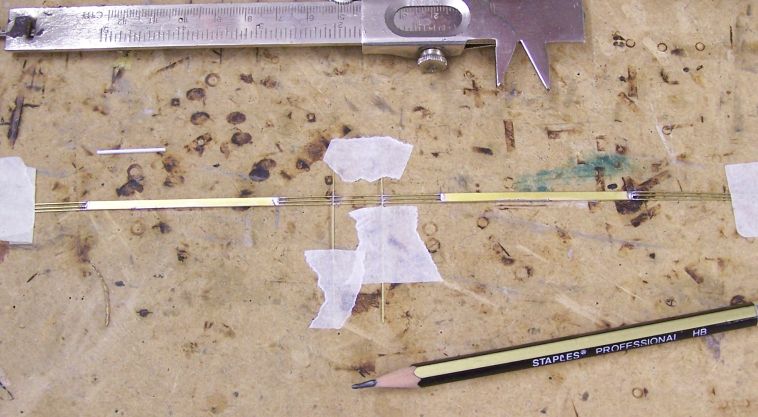
It's all made with .45 wire, dimensions from the Isinglass drawing initially then worked out on the WSM casting itself.
I reckoned the best way to attach it would be low melt round the top of the flare behind the coal plates, so the paint had to be taken off for the solder to key to.
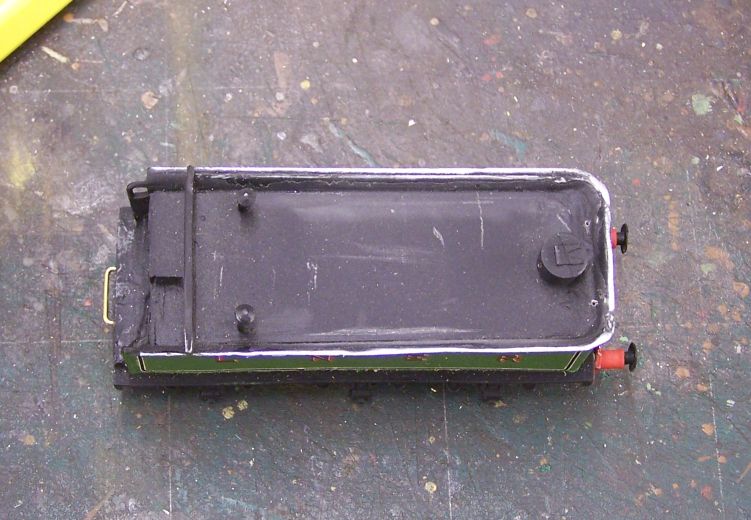
The front coal plate fell off, which saved me removing it - it should be at an angle and the plan was to fit the rails then fettle the plate back in between them.
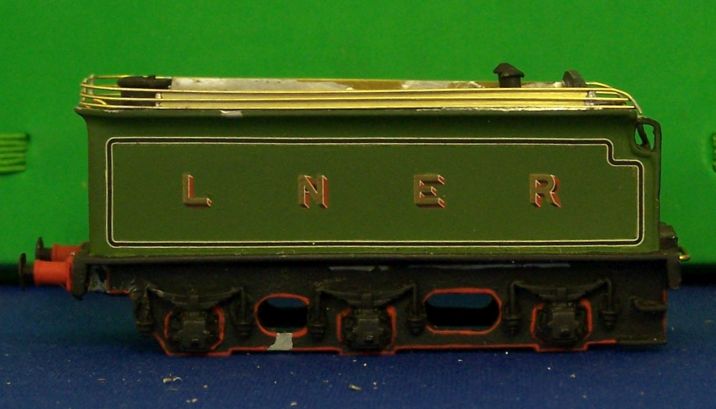
... and here it is. Not as perfect as an etched set might have been but I can spot a little solder along the top to straighten that rail and bend the front in slightly to merge better. This is the worse of the two sides anyway and once it's black and moving, who'll spot it? The overall effect is much better, they' have stuck out like a sore thumb if they'd been missing.
I only had a short time at the bench last night so I tackled a job I'd been lining up for a while - coal rails for the WSM tender. 4412 was a 3 rail loco and the tender as it was looked nothing far short of bizarre. Did the kit ever contain them or was it only ever intended to be built in GNR condition?

It's all made with .45 wire, dimensions from the Isinglass drawing initially then worked out on the WSM casting itself.
I reckoned the best way to attach it would be low melt round the top of the flare behind the coal plates, so the paint had to be taken off for the solder to key to.

The front coal plate fell off, which saved me removing it - it should be at an angle and the plan was to fit the rails then fettle the plate back in between them.

... and here it is. Not as perfect as an etched set might have been but I can spot a little solder along the top to straighten that rail and bend the front in slightly to merge better. This is the worse of the two sides anyway and once it's black and moving, who'll spot it? The overall effect is much better, they' have stuck out like a sore thumb if they'd been missing.
Last edited by jwealleans on Wed Dec 19, 2018 4:41 pm, edited 2 times in total.
-
earlswood nob
- LNER A4 4-6-2 'Streak'
- Posts: 1669
- Joined: Tue Mar 09, 2010 9:23 am
- Location: Surrey
Re: West End Workbench
Good morning all
The one WSM kit that I have (D2 I think) came with coal rails fixed to the inside of the box lid.
They didn't look too good, and I resolved to make new ones out of brass wire as JW has done.
Earlswood nob
The one WSM kit that I have (D2 I think) came with coal rails fixed to the inside of the box lid.
They didn't look too good, and I resolved to make new ones out of brass wire as JW has done.
Earlswood nob
-
jwealleans
- LNER A4 4-6-2 'Streak'
- Posts: 4303
- Joined: Wed Oct 25, 2006 8:46 am
Re: West End Workbench
Went down to Hull Show yesterday - always worth a trip and didn't disappoint. Peter and I lent a hand of Leeds Central, the first time I've seen it and it didn't disappoint either. On the Wizard Models stand at Hull show, an announcement of a new kit:
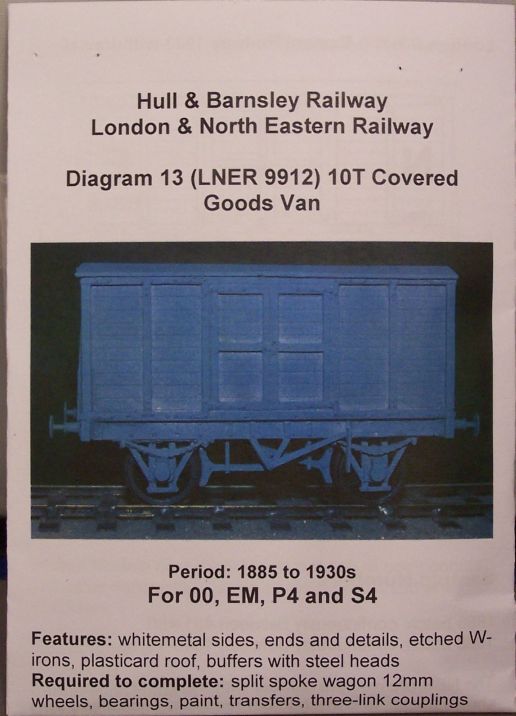
Bought one (well, it would be rude not to). This morning, looking for a little job to do and never one to resist a wagon kit for long...
It gave me a chance to try this little gadget out:
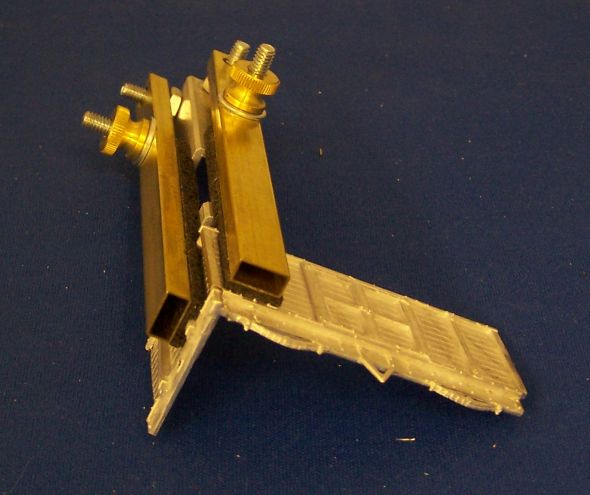
and all in all it makes up rather nicely:
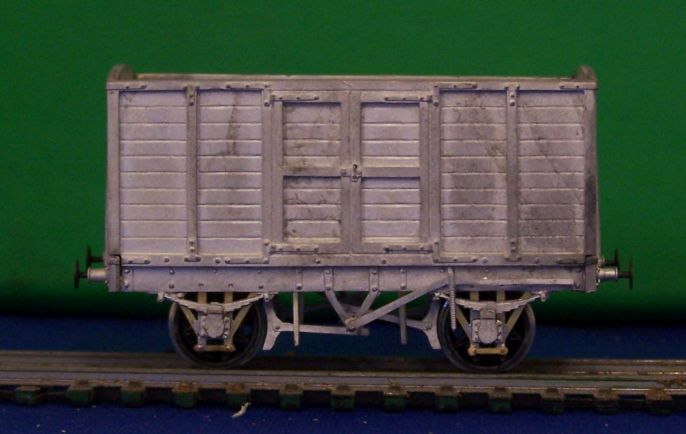
Nice two part buffers, etched W irons, rocking at one end, clean square castings - pleasure to build. Just needs a wash and a roof and it's ready for the paint shop.

Bought one (well, it would be rude not to). This morning, looking for a little job to do and never one to resist a wagon kit for long...
It gave me a chance to try this little gadget out:

and all in all it makes up rather nicely:

Nice two part buffers, etched W irons, rocking at one end, clean square castings - pleasure to build. Just needs a wash and a roof and it's ready for the paint shop.
Last edited by jwealleans on Wed Dec 19, 2018 4:41 pm, edited 3 times in total.
- Dave
- LNER A4 4-6-2 'Streak'
- Posts: 1733
- Joined: Sat Nov 13, 2010 9:33 pm
- Location: Centre of the known universe York
Re: West End Workbench
Jonathan,
I will have too get one of those vans, looks a nice little kit. I have been toying with buying one of those clamps, but last time I looked they were out of stock. Do they really work, and what size is the one you have.
I will have too get one of those vans, looks a nice little kit. I have been toying with buying one of those clamps, but last time I looked they were out of stock. Do they really work, and what size is the one you have.
-
jwealleans
- LNER A4 4-6-2 'Streak'
- Posts: 4303
- Joined: Wed Oct 25, 2006 8:46 am
Re: West End Workbench
I meant to be a bit more informative in my post, but I was rushing to get away before the traffic got too bad (I have come down to the smelly south for the week). They're called Coffman clamps, the 'right clamp' (which this is) only comes in one size which is about four inches long. I got mine from Finney and Smith, but they are closing down (I guess it's the same - Martin - Finney?) and their website redirects you to Branchlines.
- Robpulham
- LNER A4 4-6-2 'Streak'
- Posts: 1721
- Joined: Thu Mar 27, 2008 9:54 pm
- Location: Lower Wensleydale
- Contact:
Re: West End Workbench
Hi Jonathan,
They used to do three sizes 4",6" and 8" - the one that I have is 8" and can be used for assembling buildings etc with. Admittedly I have only used it on 7mm Parkside kits to date but that's the theory....
They used to do three sizes 4",6" and 8" - the one that I have is 8" and can be used for assembling buildings etc with. Admittedly I have only used it on 7mm Parkside kits to date but that's the theory....
-
jwealleans
- LNER A4 4-6-2 'Streak'
- Posts: 4303
- Joined: Wed Oct 25, 2006 8:46 am
Re: West End Workbench
Cheers, Rob. You're more informative than Coffman's website.
-
drmditch
Re: West End Workbench
This looks like an essential tool. I can find the Branchlines blog - but not a sales website.
The Coffman website is ...here.... I presume the AC-1-1 with a jaw length of 1.5" would be the most suitable?
Is it worth ordering from the US?
The Coffman website is ...here.... I presume the AC-1-1 with a jaw length of 1.5" would be the most suitable?
Is it worth ordering from the US?
-
jwealleans
- LNER A4 4-6-2 'Streak'
- Posts: 4303
- Joined: Wed Oct 25, 2006 8:46 am
Re: West End Workbench
I'll have to measure mine when I get home, David. Looking at it against the kit, 1.5" can't be far away.
WRT buying from the US, it's only really worthwhile if your parcel isn't likely to attract the attention of HMRC and have duty slapped on it. I've bought two lots of second hand kits from the US - one was taxed, one wasn't and there doesn't seem to be much rhyme or reason to it. Branchlines might be a better bet.
WRT buying from the US, it's only really worthwhile if your parcel isn't likely to attract the attention of HMRC and have duty slapped on it. I've bought two lots of second hand kits from the US - one was taxed, one wasn't and there doesn't seem to be much rhyme or reason to it. Branchlines might be a better bet.